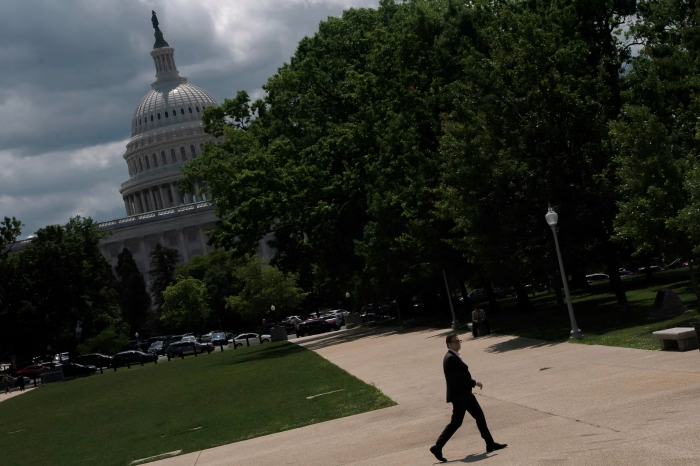In the fractured landscape of American politics, one myth has gained significant traction in recent years: the idea of the “uniparty.” This term has been used by various political factions to describe a supposed coalition of Democrats and Republicans working together in secret to undermine the interests of ordinary Americans. According to its proponents, this uniparty elite secretly agrees on major issues while pretending to oppose each other in public. This narrative, while appealing to some, is a myth—one that has contributed to the current political dysfunction in Washington, D.C., and played a significant role in the recent shutdown of the U.S. House of Representatives.
The idea of the uniparty has been a cornerstone of populist rhetoric, gaining strength during the Trump era and persisting through the rise of progressive and conservative outsiders. The uniparty myth argues that both parties in Congress are more interested in maintaining their power and advancing their agendas than in serving the public. This view resonates particularly with those frustrated by the lack of meaningful progress on issues like healthcare, immigration, and fiscal policy. While this theory has been criticized by political analysts, it has had real consequences—particularly when it comes to gridlock in the House of Representatives.
The Rise of the ‘Uniparty’ Narrative
The uniparty narrative has gained momentum in recent years, largely as a reaction to the perceived stagnation of the political system. Many voters—especially those disillusioned with the establishment—have become increasingly skeptical of both major political parties. They argue that Democrats and Republicans are, at their core, more interested in perpetuating their power than in addressing the real needs of the country.
This sentiment has been amplified by the increasing polarization in U.S. politics. The election of Donald Trump in 2016 represented a rejection of the political establishment by many voters, and his presidency only deepened the divisions within American political discourse. Throughout his time in office, Trump repeatedly painted the Republican Party as the true representative of the American people, in contrast to what he called the “deep state” or the “swamp,” which allegedly included both Democrats and establishment Republicans working together behind the scenes.
Similarly, left-wing populists have promoted the idea of a “corporate duopoly” in which both parties serve the interests of big business, leaving ordinary Americans behind. Progressives like Bernie Sanders and Alexandria Ocasio-Cortez have used this narrative to argue that the Democratic Party, in particular, has been co-opted by corporate donors and special interests. As a result, they claim that both parties are part of a larger uniparty structure, committed to maintaining a status quo that benefits elites rather than the people.
How the Myth Shut Down the House
While the uniparty myth has been widely circulated, its impact on the functioning of the U.S. government has been far from theoretical. In reality, this narrative has contributed to the dysfunction in the House of Representatives, where gridlock and deadlock have been the norm for several years. The myth has become an excuse for inaction, allowing lawmakers to avoid addressing difficult issues by blaming a supposed conspiracy between the two major parties.
The shutdown of the House, in particular, can be traced to the rise of the uniparty myth. Here’s how:
1. Distrust Between Factions
The myth of a uniparty alliance has led to an increasing distrust between different factions within Congress. In recent years, both parties have become more entrenched in their positions, often assuming that any compromise with the other side is a betrayal of their own values. This lack of trust has paralyzed the legislative process, especially in the House of Representatives, where leadership struggles between moderates and more ideologically rigid members of both parties have become more pronounced.
Moderate Republicans and Democrats are often caught between their party leadership and more extreme elements within their own ranks. The rise of far-right populism, especially in the GOP, has fueled this dynamic. Members of Congress who once prided themselves on working across the aisle now face intense pressure from their own base to adhere to party lines, and any effort to negotiate with the opposition is viewed as giving in to the “uniparty” forces that many believe are secretly working together.
2. Disruption of the Legislative Process
The uniparty myth also feeds into the idea that all efforts at bipartisan cooperation are tainted. This narrative has contributed to a growing reluctance to engage in any meaningful compromise. As a result, the legislative process has become more chaotic, with bills being held up, funding battles dragging on, and the business of government coming to a standstill. This dysfunction reached its peak when Speaker of the House Kevin McCarthy faced a revolt from his own party, with far-right members accusing him of being too willing to work with Democrats, which they argued was a sign of being part of the uniparty. In turn, McCarthy’s leadership was undermined, and the Republican Party was thrust into turmoil, resulting in the temporary shutdown of the House.
3. The Impact of the Far-Right
The rise of far-right factions within the Republican Party, such as the House Freedom Caucus, has been one of the primary catalysts for the current gridlock. These hardline conservatives have adopted the uniparty myth as a central tenet of their political identity, seeing any compromise or deal-making with Democrats as evidence of betrayal. In their eyes, even moderate Republicans who work with Democrats to pass bills on issues like government spending or defense policy are guilty of enabling the uniparty. This mindset has made it increasingly difficult for party leadership to maintain control over their own ranks, leading to chaos and inaction.
One of the most significant consequences of this is the paralysis in Congress, where legislation is frequently blocked due to ideological purity tests. The House has seen multiple instances where funding bills, including those needed to keep the government running, were held hostage by the threat of far-right opposition. This has led to repeated budget crises, government shutdowns, and political gridlock that harm the country’s functioning.
4. The Cult of Purity
In many ways, the uniparty myth has fueled a culture of ideological purity within both major parties. Each faction believes it is fighting a righteous battle against the forces of corruption represented by the other side. As a result, there is little room for compromise or collaboration. This inflexibility has contributed to repeated government shutdowns, as neither side is willing to make the concessions necessary to pass critical funding bills.
The myth of the uniparty fuels this desire for purity, creating a situation where neither party is willing to give an inch, fearing that any form of compromise will be seen as a betrayal by their most loyal supporters. This rigidity has paralyzed the House, causing legislative stagnation and hampering the ability of Congress to address the country’s most pressing issues.
Conclusion: The Cost of the Uniparty Myth
The myth of the uniparty has done real damage to the functioning of the U.S. House of Representatives, leading to gridlock, distrust, and dysfunction. While the idea of a secret coalition of Democrats and Republicans working together may make for compelling rhetoric, it does not reflect the true dynamics of modern American politics. The uniparty myth has contributed to the breakdown of cooperation between the two parties, making it harder for lawmakers to pass essential legislation.
At its core, the uniparty myth is a distraction from the real issues that need to be addressed. Instead of focusing on meaningful policy solutions, political leaders have become consumed by the need to prove their loyalty to their respective bases, rather than to the nation. As the country faces increasingly complex challenges, the myth of the uniparty only serves to shut down the House and impede progress. Until this myth is dismantled, the political dysfunction in Washington will only continue to deepen.



